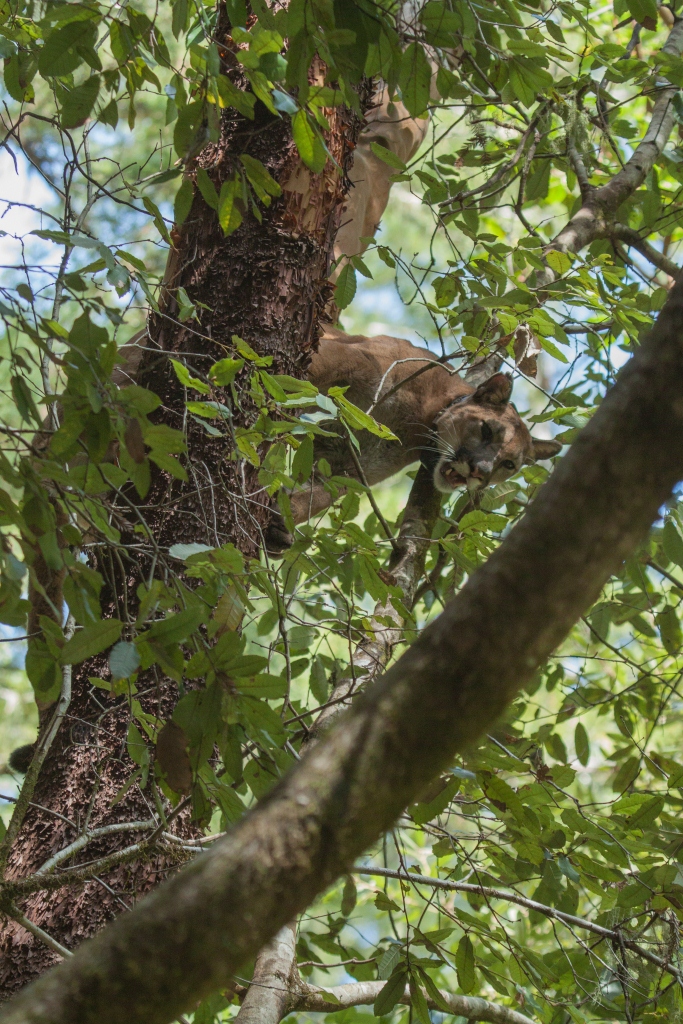We recently recaptured puma 29F. The batteries on her collar were many weeks beyond the estimated date it’d run out of power. Typically, we recapture and replace the collar on a puma with a safer margin of battery power, but apprehending 29F was a real challenge.
29F makes her home uphill from the university here in Santa Cruz. We first captured her in a state park north of her current home, and she slowly shifted her territory southward – away from the areas with large open space and into an amalgamation of housing parcels and park boundaries that appear to have been drawn by a kindergartener.
Capturing a puma in a setting such as this requires an “anchored” approach like the giant Have-A-Heart traps we sometimes use – something that is put in one place and that limits all of the activity to that one site. We don’t use trailing hounds in settings like this because of the chance the puma and dogs will cross property lines and roads. The trick with traps, however, is that some animals become “trap shy”, meaning they are discomforted by the trap or remember it from a prior experience and avoid it. This is exactly why 29F’s collar came so close to running out – she’d become trap shy after her first capture. On 3 separate occasions I’d found freshly-killed deer that 29F was eating and pulled them into the trap, and on each occasion she never returned. And all-the-while the collar battery-life was seeping away.
It stands to reason that a wild animal that lives in and amongst people might be savvier about man-made structures like traps than an animal in the middle of the wilderness that isn’t often exposed to such things. The exact same scenario happened with puma 19F near Saratoga a year earlier (although we tried trapping 6 times with her). It ultimately required the careful use of trailing hounds to capture her on a large county park. After the 3rd failed trapping attempt with 29F, it was apparent that she would also require hounds to capture. Unlike 19F, there were no obvious large parcels where we could use hounds without risk of the pursuit going “out-of-bounds”. However, there were two moderate-sized open-space parcels adjacent to one another in the center of her territory that granted us permission to try “just one time” to use a single pair of hounds, provided we could keep careful track of the dogs. The last piece was to wait for 29F to travel onto one of these two parcels. One day last week, the radio signal on her tracking collar indicated she’s moved onto the parcels.
29F’s story is much bigger than simply catching and collaring her, so I’ll forgo the details about the hound capture, except to say that it was short and efficient and that a little over an hour after we caught her she was up and walking again with a new collar that would last two years instead of one.
We are fortunate to be able to follow pumas like 29F, because they provide valuable insights into how secretive animals live their lives as our neighbors, including how they manage major life-tasks we can relate to such as raising their young and finding mates and food. In the case of 29F, she is also one of my neighbors because my house and neighborhood are against open space that is part of her territory. GPS locations show she sometimes comes close-in (please check out the Puma Tracker to gain this view of a puma’s life). Knowing about 29F’s life gives me a much larger context in which to place stories I hear about someone’s fleeting glance of a long tail crossing the road in their headlights, or a friend finding puma tracks on a dusty park trail, or warnings on the neighborhood email list about a lion seen near someone’s animal pen. All of these are fleeting moments when our lives intersect with our animal neighbors, each of us going about our respective lives. And the same can be said for all our animal neighbors – deer, coyotes, crows, warblers, frogs, and salmon to name but a few. These animals have no knowledge of property boundaries or human laws – the things we as people create and navigate. Yet, these things also impact their lives and they create find their own ways to live with their effects. Studying how pumas do that presents many challenges, yet presents us with the opportunities to change our habits to be more neighborly.

